
Wine Culture and Information since 2002 - Volume 22
 Wine Culture and Information since 2002 - Volume 22 |
|
Comparing MerlotThe famous red grape from Bordeaux is compared in three Italian wines, excellent representatives of high enology, in which Merlot fully expresses its personality |
|
Merlot, a name which, on its own, is for many people a guarantee of elegance, class and great wines. The famous grape from Bordeaux - indeed, one of the most famous ones - has conquered, in the course of years, a high reputation therefore becoming well known in every country of the world. Most of the times, it is enough its presence in a wine in order to have it climbing many positions towards the Olympus of enology, a fact which should certainly be considered more a fashion than a real merit. Although it is absolutely unquestionable Merlot is capable of making wines of primary greatness, smooth and charming wines which fascinate for their elegance, without renouncing - when it is vinified in this sense - to a full body. It is right its remarkable smoothness to make it interesting for wineries, in particular when astringency and aggressive tannins are present in a wine or in case of a remarkable acidity. In these cases, Merlot has not rivals, its touch is always unmistakable. Merlot is also used alone for the production of interesting wines and - when quality production criteria are adopted - the results undoubtedly are enthusiastic. In this sense, The versatility of Merlot is remarkable: from simple and immediate wines to complex, robust and dense wines. Moreover, Merlot is a grape which is particularly suited for barrels - and in particular with barrique - becoming, in most cases, an almost indissoluble couple. Although many wines produced with Merlot grapes are aged in inert containers - such as steel tanks - this grape has its main representation with the barrique, which is also from Bordeaux. Even when it is vinified without using the barrique - and always in cases of quality production - Merlot grape gives interesting and pleasing wines, in which its immediate smoothness always represents the main characteristic.
|
|
The purpose of our comparative tasting about Merlot is to highlight the specific peculiarities of the grape and how they are frequently evident and recognizable even in the case it is being cultivated in different areas. As the most common practice in the vinification of Merlot is using the barrique - more infrequently the cask - the three wines of our comparative tasting are produced with this technique. Our goal will also be to understand Merlot's gustatory organoleptic qualities, in particular smoothness which - as we will see - even in case of robust and full bodied wines, it is always present. This will also allow to understand smoothness is not always a typical quality in “simple” wines: in case Merlot is vinified according to specific criteria of quality and with low yields, its body expresses all of its consistency, even though mitigated by the typical roundness of the grape.
The first wine selected for our comparative tasting is Volpe Pasini's Focus Merlot Zuc di Volpe, a famous producer from Colli Orientali del Friuli. This Merlot ages in barrique for 12 months followed by 8 months of aging in bottle. The second wine of our tasting is Tenuta San Leonardo's Villa Gresti, a full bodied Merlot aged in barrique for 14 months and 12 months in bottle. The third wine is Castellare di Castellina's Poggio ai Merli, a robust Merlot aged for 30 months in barrique and for 12 months in bottle. We selected three Merlot wines from three different Italian regions: Friuli Venezia Giulia, Trentino and Tuscany. The three wines will be served at a temperature of 18°C (64°F), in order to favor the development of wine's aromas and to exalt smoothness given both by the grape and aging. The comparative tasting will be done by using three ISO tasting glasses. For our comparative tasting we will use wines belonging to the latest vintages currently available in the market.
|
||||||||
|
Merlot is a grape variety with a medium coloring capability, therefore its wines show pretty deep intensities, while the transparency can vary - according to the quality of production - from pretty transparent to impenetrable to light. Wines produced with Merlot grape show intense ruby red color and - because of the moderate longevity - garnet red nuances begin to become evident even after four or five years. The evolution of Merlot wines produced with quality criteria is different and - in particular - with low yield in vineyards. In these cases, the longevity is longer and the tendency to show garnet red nuances is delayed. Merlot wines aged in barrique - as in the case of the samples of our comparative tasting - usually get more intense and deep colors than the ones exclusively aged in inert containers, such as steel tanks. The first wine we are going to examine is Volpe Pasini's Focus Merlot Zuc di Volpe. The color of this Merlot - observed on the base of the glass - shows a dark ruby red color and a pretty little transparency. By tilting the glass on a white surface - an operation which will allow the evaluation of nuances - it can be observed, on the edge of the liquid mass towards the opening, ruby red hues. The second wine of which we will observe color is Tenuta San Leonardo's Villa Gresti. The color of this Merlot is not so different from the previous wine: dark ruby red color and ruby red nuances, very little transparency. Even in the last wine - Castellare di Castellina's Poggio ai Merli - the appearance does not change in regard to the previous wines. Even in this case, it will be possible to observe a dark ruby red color and ruby red nuances, very reduced transparency. The scarce transparency observable in these three wines, is the sign of precise choices of producers in the cultivation of the grapes: low yields in order to increase the concentration of the wine and of the coloring substances.
|
|
Merlot probably is the most used grape variety in wine making with barrique or however with cask. Thanks to its characteristics, Merlot is a grape variety particularly suited to this style of vinification and - in this sense - represents the favorite grape variety of those who look for the typical qualities of wood in wines. Of course, Merlot does not mean wood only. The famous grape from Bordeaux - like already mentioned - is pretty suited to the vinification in steel tanks, making pleasing and fragrant wines. According to an aromatic point of view, Merlot can express interesting aromas of red and black fruits as well as of flowers and - in case it is fermented or aged in barrique - the sequence of spicy and balsamic aromas is pretty frequent. This is the specific case of the wines of our comparative tasting, all the three being vinified by using the barrique and with pretty similar periods of aging. The first wine we will examine is Volpe Pasini's Focus Merlot Zuc di Volpe. By holding the glass in a vertical position and without swirling it, we will proceed with the evaluation of opening aromas. There will be perceived intense aromas of black currant - one of Merlot's typical fruity aromas - plum and black cherry, also in this case, typical in this grape variety. After having swirled the glass, we will proceed with a second smell, which will allow the perception of blueberry and violet, followed by other typical aromas of the aging in barrique, such as vanilla, liquorice, tobacco, cocoa, cinnamon, mace and pink pepper, as well as a pleasant balsamic aroma of menthol. It is important to notice the good aromatic balance in this wine and - in particular - its complexity, sign, first of all, of the aging in barrique. The second wine of which we will examine aromas is Tenuta San Leonardo's Villa Gresti. Opening aromas will be characterized by black currant and black cherry, typical in Merlot. After having swirled the glass, we will proceed with a second smell, which will allow the perception of black currant, raspberry, plum and cyclamen aromas, followed by an aromatic series given by the barrique, such as vanilla, toasted wood, licorice and cocoa, as well as a pleasing and evident balsamic aroma of eucalyptus. In Merlot wines aged in barrique, balsamic aromas are pretty frequent, in particular eucalyptus. The last wine we will examine is Castellare di Castellina's Poggio ai Merli. The opening aromas of this wine reveal intense hints of plum, black cherry and black currant, also in this case, very typical aromas of Merlot. The second smell - after the glass has been swirled - will reveal aromas of blackberry and dried violet, as well as aromas of rhubarb, licorice, tobacco, vanilla, nutmeg, and hints of cinchona and bell pepper. In particular, the aroma of bell pepper - a typical quality of Cabernet Sauvignon and even more of Cabernet Franc - can develop in Merlot as well, especially when it does not reach full ripeness or it is being cultivated in areas with a cool climate.
|
||||
|
The main gustatory quality of Merlot is represented by smoothness, a roundness given by its non particularly aggressive tannins. For this reason, Merlot is frequently vinified with other “harsher” grapes, in order to make them less aggressive. Moreover, its “round” tannins can be well supported by the addition of wood's tannins - including the astringent ones of new and strongly toasted barriques - always allowing the making of immediate and pleasing wines. In this way it is possible - together with proper cultivation practices - to obtain robust and full bodied wines, such as the case of the wines of our comparative tasting. The first wine we will examine is Tenuta San Leonardo's Villa Gresti. The attack in the mouth of this wine is pretty tannic even though - after few moments - the typical smoothness of Merlot will become evident. It is important to notice - in particular - the full and robust body of this wine and the role played by alcohol in the balance, as well as its contribution to the smoothness of the wine. The second wine we will examine is Volpe Pasini's Focus Merlot Zuc di Volpe. The attack in the mouth is pretty tannic - more astringent than the previous wine - and, also in this case, after few seconds, it will be noticed the typical smoothness of Merlot. The wine is perfectly balanced by alcohol - which contributes to increase smoothness - and it is important to notice the perfect correspondence to the nose, and in particular the taste of black currant and black cherry. Let's now examine the last wine, Castellare di Castellina's Poggio ai Merli. The attack in in the mouth is - once again - tannic and robust, although having a pleasing and evident smoothness, a quality which fascinate Merlot fans. The correspondence to the nose is excellent: also in the mouth, it can be perceived black currant, plum and black cherry. The role played by alcohol in the balance is once again impeccable, contributing - just like in the previous cases - to emphasize smoothness.
|
|
The wines of our comparative tasting certainly are three excellent exemplars produced with Merlot grape. The full body is well mitigated by the typical smoothness of Merlot, a quality which certainly makes these wines pleasing and easy to appreciate, without diminishing their real and high prestige at all. The finish of these three wines is characterized from a long taste-olfactory persistence where - once again - we can find an excellent correspondence to the aromas of fruits perceived to the nose. In particular, it can be noticed black currant, black cherry and plum - three typical organoleptic qualities of Merlot - as well as raspberry flavor found in Villa Gresti, a quality which gives more freshness to the wine. Merlot is a grape offering a remarkable versatility in the cellar and - in particular - in the glass, where its pleasing aromas of red and black fruits together with a pretty smooth taste - immediate and pleasing - which can make gentle even robust and full bodied wines, such as in the case of the three samples of our comparative tasting.
|
Wines of the Month |
|
|
|
Score legend Prices are to be considered as indicative. Prices may vary according to the country or the shop where wines are bought |
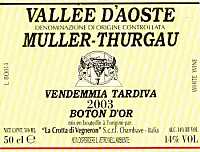
|
|
Vallée d'Aoste Müller Thurgau Vendemmia Tardiva Boton d'Or 2003 |
|
| La Crotta di Vegneron (Vallée d'Aoste, Italy) | |
| Grapes: Müller Thurgau | |
| Price: € 17.50 - 50cl | Score: |
| The wine shows a brilliant golden yellow color and nuances of golden yellow, very transparent. The nose denotes intense, clean, pleasing and refined aromas which start with hints of grape and peach followed by aromas of banana, litchi, quince, acacia honey, broom and pear. The mouth has good correspondence to the nose, a crisp attack and pleasing sweetness, however balanced by alcohol, good body, intense flavors. The finish is persistent with flavors of peach, grape and pear. | |
| Food Match: Fruit and cream desserts | |
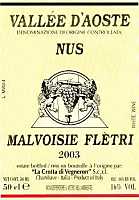
|
|
Vallée d'Aoste Nus Malvoisie Flètri 2003 |
|
| La Crotta di Vegneron (Vallée d'Aoste, Italy) | |
| Grapes: Nus Malvoisie | |
| Price: € 24.50 - 50cl | Score: |
| This wine shows a brilliant amber yellow color and nuances of golden yellow, very transparent. The nose reveals intense, clean, pleasing, refined and elegant that start with hints of raisin, honey and dried fig followed by aromas of dried apricot, peanut butter, date, quince jam, almond, lavender and vanilla. The mouth has good correspondence to the nose, a sweet attack and pleasing crispness, however balanced by alcohol, good body, intense flavors. The finish is persistent with flavors of raisin, honey, date and dried apricot. A well made wine. Nus Malvoisie Flètri ferments in cask. | |
| Food Match: Confectionery, Dried fruits desserts and tarts | |
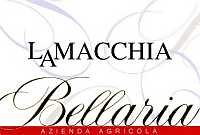
|
|
La Macchia 2000 |
|
| Bellaria (Lombardy, Italy) | |
| Grapes: Merlot | |
| Price: € 15.00 | Score: |
| The wine shows an intense ruby red color and nuances of ruby red, little transparency. The nose reveals intense, clean, pleasing and refined aromas that start with hints of black cherry, black currant and plum followed by aromas of violet, vanilla, licorice, eucalyptus, tobacco, pink pepper and cocoa. The mouth has good correspondence to the nose, a tannic attack and however balanced by alcohol, good body, intense flavors, agreeable. The finish is persistent with flavors of black cherry and plum. La Macchia ages for 24 months in barrique followed by at least 12 months of aging in bottle. | |
| Food Match: Roasted meat, Braised and stewed meat, Hard cheese | |
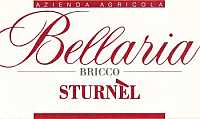
|
|
Bricco Sturnel 1999 |
|
| Bellaria (Lombardy, Italy) | |
| Grapes: Cabernet Sauvignon (80%), Barbera (20%) | |
| Price: € 15.00 | Score: |
| The wine shows an intense ruby red color and nuances of garnet red, little transparency. The nose reveals intense, clean, pleasing, refined and elegant aromas which start with hints of plum and blueberry followed by aromas of black cherry, black currant, blackberry, violet, vanilla, licorice, tobacco, carob, mace, pink pepper and menthol. The mouth has good correspondence to the nose, a tannic attack and pleasing crispness, however well balanced by alcohol, full body, intense flavors. The finish is persistent with flavors of plum and black cherry. A well made wine. Bricco Sturnel ages for 20 months in barrique followed by at least 12 months of aging in bottle. | |
| Food Match: Game, Roasted meat, Braised and stewed meat, Hard cheese | |
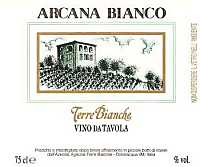
|
|
Arcana Bianco 2004 |
|
| Terre Bianche (Liguria, Italy) | |
| Grapes: Vermentino (50%), Pigato (50%) | |
| Price: € 12.50 | Score: |
| This wine shows an intense golden yellow color and nuances of straw yellow, very transparent. The nose denotes intense, clean, pleasing and refined aromas which start with hints of apple and plum followed by aromas of pineapple, hawthorn, hazelnut, honey, toasted, grapefruit and hints of rosemary. The mouth has good correspondence to the nose, a crisp attack and pleasing roundness, however balanced by alcohol, good body, intense flavors. The finish is persistent with flavors of plum, pineapple and apple. Arcana Bianco ferments and ages in barrique for 6 months. | |
| Food Match: Roasted white meat, Stuffed pasta, Roasted fish | |
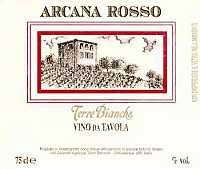
|
|
Arcana Rosso 2001 |
|
| Terre Bianche (Liguria, Italy) | |
| Grapes: Rossese (60%), Cabernet Sauvignon (40%) | |
| Price: € 15.50 | Score: |
| The wine shows an intense ruby red color and nuances of garnet red, little transparency. The nose denotes intense, clean, pleasing and refined aromas which start with hints of black cherry, plum and black currant followed by aromas of blueberry, licorice, chocolate, eucalyptus and vanilla. The mouth has good correspondence to the nose, a tannic attack and however balanced by alcohol, good body, intense flavors. The finish is persistent with flavors of black cherry, plum and black currant. Arcana Rosso ages for 12 months in barrique. | |
| Food Match: Roasted meat, Braised and stewed meat, Hard cheese | |
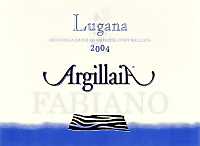
|
|
Lugana Argillaia 2004 |
|
| Fabiano (Veneto, Italy) | |
| Grapes: Trebbiano di Lugana | |
| Price: € 5.40 | Score: |
| The wine shows a pale straw yellow color and nuances of greenish yellow, very transparent. The nose denotes intense, clean and pleasing aromas which start with hints of pear, apple and almond followed by aromas of hawthorn, toasted, honey and plum. The mouth has good correspondence to the nose, a crisp attack and pleasing roundness, however balanced by alcohol, good body, intense flavors. The finish is persistent with flavors of apple and plum. A small part of this Lugana ferments in barrique. | |
| Food Match: Pasta and risotto with fish and vegetables, Broiled fish | |
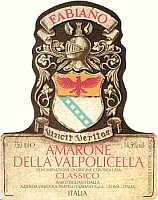
|
|
Amarone della Valpolicella Classico 2000 |
|
| Fabiano (Veneto, Italy) | |
| Grapes: Corvina (65%), Rondinella (30%), Molinara (5%) | |
| Price: € 21.60 | Score: |
| The wine shows a brilliant ruby red color and nuances of garnet red, moderate transparency. The nose reveals intense, clean, pleasing and refined aromas which start with hints of black cherry, plum and blackberry followed by aromas of violet, blueberry, vanilla, tobacco, licorice, cinnamon, cocoa and mace. The mouth has good correspondence to the nose, a tannic attack and however balanced by alcohol, full body, intense flavors, agreeable. The finish is persistent with flavors of black cherry, plum and blackberry. This Amarone ages for 3 years of which at least 10 months in cask. | |
| Food Match: Game, Roasted meat, Braised and stewed meat, Hard cheese | |
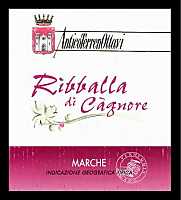
|
|
Ribballa di Cagnore 2002 |
|
| Antico Terreno Ottavi (Marches, Italy) | |
| Grapes: Montepulciano | |
| Price: € 16.00 | Score: |
| This wine shows an intense ruby red color and nuances of ruby red, little transparency. The nose denotes intense, clean, pleasing and refined aromas which start with hints of black cherry, plum and black currant followed by aromas of blueberry, licorice, cocoa, tamarind, vanilla and hints of black pepper and menthol. The mouth has good correspondence to the nose, a tannic attack and however balanced by alcohol, good body, intense flavors. The finish is persistent with flavors of black cherry, plum and black currant. This wine ages for 16-18 months in barrique. | |
| Food Match: Roasted meat, Stewed and braised meat, Hard cheese | |
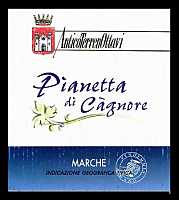
|
|
Pianetta di Cagnore Le Goduriose 2002 |
|
| Antico Terreno Ottavi (Marches, Italia) | |
| Grapes: Vernaccia Nera | |
| Price: € 20.00 | Score: |
| The wine shows a brilliant ruby red color and nuances of ruby red, little transparency. The nose reveals intense, clean, pleasing and refined aromas which start with hints of black cherry, blueberry and raspberry followed by aromas of cyclamen, plum, vanilla, licorice, tobacco, pink pepper and menthol. The mouth has good correspondence to the nose, a slightly tannic attack and however balanced by alcohol, good body, intense flavors. The finish is persistent with flavors of black cherry, raspberry and blueberry. This wine ages for 14-18 months in barrique. | |
| Food Match: Roasted meat, Stewed and braised meat with mushrooms, Hard cheese | |
|
||||||||
|
DiWineTaste Polls
|
| |||||||
Privacy Policy | |||||||


| Copyright © 2002-2024 Antonello Biancalana, DiWineTaste - All rights reserved |
| All rights reserved under international copyright conventions. No part of this publication and of this WEB site may be
reproduced or utilized in any form or by any means, electronic or mechanical, without permission in writing from DiWineTaste. |